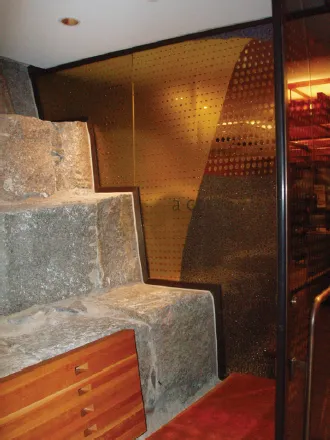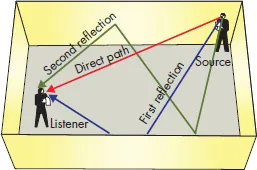
- English
- ePUB (mobile friendly)
- Available on iOS & Android
eBook - ePub
Materials for Interior Environments
About this book
Organized by types of materials and applications, this guide helps designers successfully address material evaluation and selection of interior components. Engagingly written, highly detailed, and helpfully illustrated with more than 550 color illustrations, Materials for Interior Environments is a comprehensive guide to everything a designer needs to know about the materials available for interiors—from aesthetic qualities to manufacturing and fabrication, applications, installation and maintenance, and specifications for materials used in commercial and residential applications.
Frequently asked questions
Yes, you can cancel anytime from the Subscription tab in your account settings on the Perlego website. Your subscription will stay active until the end of your current billing period. Learn how to cancel your subscription.
No, books cannot be downloaded as external files, such as PDFs, for use outside of Perlego. However, you can download books within the Perlego app for offline reading on mobile or tablet. Learn more here.
Perlego offers two plans: Essential and Complete
- Essential is ideal for learners and professionals who enjoy exploring a wide range of subjects. Access the Essential Library with 800,000+ trusted titles and best-sellers across business, personal growth, and the humanities. Includes unlimited reading time and Standard Read Aloud voice.
- Complete: Perfect for advanced learners and researchers needing full, unrestricted access. Unlock 1.4M+ books across hundreds of subjects, including academic and specialized titles. The Complete Plan also includes advanced features like Premium Read Aloud and Research Assistant.
We are an online textbook subscription service, where you can get access to an entire online library for less than the price of a single book per month. With over 1 million books across 1000+ topics, we’ve got you covered! Learn more here.
Look out for the read-aloud symbol on your next book to see if you can listen to it. The read-aloud tool reads text aloud for you, highlighting the text as it is being read. You can pause it, speed it up and slow it down. Learn more here.
Yes! You can use the Perlego app on both iOS or Android devices to read anytime, anywhere — even offline. Perfect for commutes or when you’re on the go.
Please note we cannot support devices running on iOS 13 and Android 7 or earlier. Learn more about using the app.
Please note we cannot support devices running on iOS 13 and Android 7 or earlier. Learn more about using the app.
Yes, you can access Materials for Interior Environments by Corky Binggeli in PDF and/or ePUB format, as well as other popular books in Architecture & Interior Design. We have over one million books available in our catalogue for you to explore.
Information
Part I
Design Considerations
Chapter 1
Finish Selection and Specification
There are thousands of products available for use in interior environments, and each has its assets and disadvantages. The process of selecting the right interior material for the job is sometimes bewildering. The purpose of this book is to serve as a guide for designers to learn about, evaluate, and select materials that will look good, work well, and respect human and environmental needs.
As interior designers select finishes for projects and present them to clients, they assess each alternative for its aesthetic contribution to the design concept. In addition to a material’s appearance, they consider its acoustic properties and light reflectance. The material’s shape, texture, proportion, and scale are related to the balance and symmetry of the space and the harmony of the design. Whether or not a material transmits light influences how it can be used to open or enclose a space. Each selection becomes part of complex relationships between unity and variety, rhythm and repetition, and emphasis and hierarchy. The way a material expresses its function is also part of its aesthetic quality (Figure 1.1).
Figure 1.1: Materials in Trinity Church Undercroft, Boston, Massachusetts

The selection of materials is restrained by codes and regulations that have been instituted to ensure the public’s safety. For example, interior materials can either contribute potential fuel to a fire or resist ignition and flame spread. The materials that line the paths to exits—the means of egress—are especially important.
Interior materials often affect human health and well-being, so designers must review materials for their ability to prevent slips and falls and to cushion surfaces from impact. They check details of product manufacture and installation for exposed sharp edges and shatter resistance. Electrically conductive materials are selected where static electricity is likely to cause a painful shock or affect electronic equipment. Materials that are likely to become very hot or cold require insulation from contact. Where potentially dangerous chemicals are in use, materials are selected to protect both surfaces and people. Designers should avoid materials that expose people to harmful chemicals or unsafe conditions during manufacturing, delivery, installation, use, or disposal, or that degrade indoor air quality (IAQ).
Designers consider how a material will perform under the conditions of the project. They rate materials for durability, colorfastness and fading, and stain and water resistance, and evaluate them for ease of maintenance. Materials may be tested and labeled for light, moderate, or heavy use by their manufacturer.
A material’s availability during a project’s schedule is related to manufacturing schedules and shipping and warehouse arrangements. Custom-ordered items often require longer lead times and additional paperwork. Special government conditions apply to the export or importation of rare and antique materials.
Describing the Properties of Materials
Color: property dependent on the quality and quantity of light; one or more innate colors, and possibly other colors if processed
Durability: ability to resist destructive forces, retain original appearance, and continue to function as intended
Elasticity: resiliency or flexibility; the ability to return to initial form after deformation
Form: the three-dimensional quality defined by length, width, and depth; may be linear, planar, or block-like
Plasticity: ability to be formed or shaped; allowing continuous deformation without rupturing or relaxing
Refinement: ability to form and retain precise, thin, closely spaced elements; depends on strength, durability, and manufacturing process
Strength: ability to resist stress, to bend without breaking
Texture: relative smoothness or roughness of a surface; may be large- or small-scale
Workability: the ease of altering a material from its primary form
FUNCTIONAL CRITERIA
The basic functional qualities of materials suggest their appropriate uses. These include safety, durability, comfort, ease of care, fire resistance, and acoustic properties.
Safety issues for interior materials include toxicity, health effects, slip resistance, and shatter resistance. Not only should designers select a material to be safe for use as intended, but they should also consider the unexpected; for example, wired glass will not break when hit by water from a fire hose (its intended function), but it will break if struck hard by a fist, causing cuts and bleeding. It is important to keep in mind that safety concerns change over time; when asbestos was introduced to prevent the spread of fire, its effect on human health was not clearly understood or was not considered.
Durability involves evaluating a material for its ability to stand up to its intended use. Materials may be rated for their resistance to abrasion. Some materials will melt when they come in contact with a heat source; others will deteriorate from contact with alcohol or acetone. Water will damage or weaken some materials, while others will dry out in low humidity. The preparation of the underlying substrate and the use of proper installation procedures affect the durability of a material, as does its finish.
Comfort is a functional criterion for interior materials that come in contact with the human body. A sturdy but hard chair may encourage short visits in a food court; in contrast, a cozy, large one is more likely to induce lingering. Materials that carry heat away from the human body may be welcome in a tropical climate but can feel unpleasantly cold to the touch elsewhere. The texture of a floor becomes critical for those who spend their workday on their feet.
Ease of care affects a material’s continued performance over time. A material that can be used in a carefully controlled environment with excellent maintenance procedures may not withstand exposure to unsupervised users and less diligent maintenance. Products with frequent, complex, or expensive maintenance requirements often fail to retain their initial appearance, especially if untrained personnel are performing the maintenance.
Fire resistance is such an important topic that designers often limit their initial material selections to those that meet the requirements of fire codes. Codes consider not only the ability of a material to ignite and burst into flame, but also how much smoke it will produce and whether fire will quickly spread across its surface. When exposed to fire, some materials produce toxic chemicals that may be odorless and produce no smoke or flame.
The acoustic properties of interior materials affect the acoustic quality of a space by absorbing or reflecting sound within it, and by transferring sound from one space to another (Figure 1.2).
Figure 1.2: Reflected sound

Within a space, a sound generated from one location will spread out and away from its source; this is referred to as diffusion (Figure 1.3). It continues to spread and gradually becomes weaker, which is called attenuation (Figure 1.4), until it is either absorbed or reflected by an intervening material. In some spaces, a designer will want sound to be r...
Table of contents
- Cover
- Contents
- Title
- Copyright
- Preface
- Acknowledgments
- Part I: Design Considerations
- Part II: Interior Materials
- Part III: Finish Comparisons
- Glossary
- Index